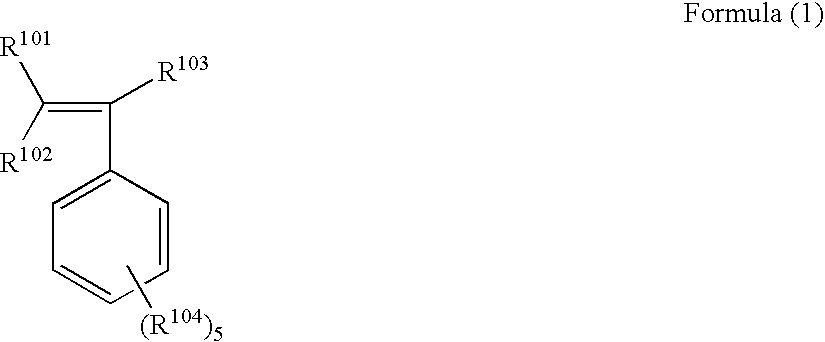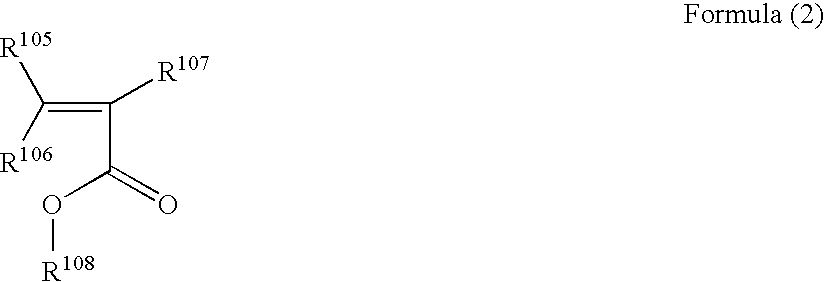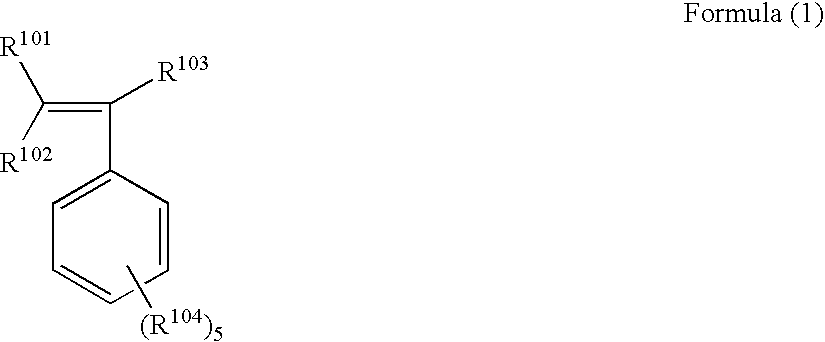Cellulose ester film, polarizer and liquid crystal display device
a technology of cellulose ester film and polarizer, which is applied in the direction of optical elements, instruments, transportation and packaging, etc., can solve the problems of difficult increase of birefringence of film, unsatisfactory level, and severe requirement of viewing angle dependence of film, etc., to achieve excellent wet heat durability of rth and dimensional change resistance, excellent humidity-dependent stability of rth, and high rth
- Summary
- Abstract
- Description
- Claims
- Application Information
AI Technical Summary
Benefits of technology
Problems solved by technology
Method used
Image
Examples
example 1
[0279]A cellulose ester dope (a) mentioned below was formed into a film according to a solution casting process.
(Cellulose Ester Dope a)
[0280]
Cellulose acetate resin: having a degree of substitution100mas. pts.shown in Table 4 belowAdditive M, in an amount shown in Table 4 (unit, mas. pt.)Retardation enhancer AA4mas. pts.Release promoter0.03mas. pts.Dichloromethane406mas. pts.Methanol61mas. pts.Retardation Enhancer AA:Retardation Enhancer AB:Retardation Enhancer AC:Release Promoter:
R═H or C2H5
[0281]The composition of the above-mentioned additive M is shown in Table 3 below, along with the compositions of other additives A to R therein. The copolymerization A and the copolymerization B of the copolymerization ingredient 1 and the copolymerization ingredient 2 that are named so for convenience′ sake are shown in Tables 4 and 5 below.
TABLE 3CopolymerizationCopolymerizationAdditiveIngredient 1Ingredient 2Astyreneo-hydroxystyreneBstyrenem-hydroxystyreneCstyrenep-hydroxystyreneDm-hydroxy...
examples 2 to 50
, Comparative Examples 1 to 6
[0284]Cellulose ester dopes were prepared in the same manner as in Example 1, for which, however, the degree of substitution of the cellulose ester resin, the type and the amount of the plasticizer, the type and the amount of the additive and the type and the amount of the retardation enhancer were changed as in Tables 4 and 5 below. In Tables 4 and 5, the plasticizer V is TPP, the plasticizer W is BDP; and the plasticizers P-1, P-6, P-20, P-32, P-38, P-47, P-52, P-53, P-54, P-55, P-60 and P-64 are the above-mentioned polymer additives, the polymers shown in the above Table 1 and Table 2. The amount of the plasticizer is in a unit of part by mass In the following Table 4 and Table 5, the cellulose ester resins are cellulose acetate resins in Examples 2 to 45, 49 and 50 and Comparative Examples 1 to 6. In Examples 46 to 48, these are cellulose acetate propionate resins. In Examples 49 and 50, two additives, additive Y (styrene / maleic anhydride copolymer, ...
examples 101 to 150
(Formation of Polarizing Element)
[0293]A polyvinyl alcohol (PVA) film having a thickness of 75 μm and a degree of polymerization of 2400 was swollen in hot water at 30° C. for 40 seconds, then colored by dipping it in an aqueous solution potassium iodide (6% by mass) having an iodine concentration of 0.06% by mass at 30° C. for 60 seconds, and thereafter stretched in the machine direction by 5.0 times the original length while dipped in an aqueous solution of potassium iodide (3% by mass) having a boric acid concentration of 4% by mass) at 40° C. for 60 seconds. Next, this was dried at 50° C. for 4 minutes to give a polarizing element.
(Preparation of Cellulose Ester Film)
[0294]The film produced in Example 1 was dipped in an aqueous sodium hydroxide solution (1.5 mol / L) at 30° C., and FUJIFILM's TD80U was in an aqueous sodium hydroxide solution (1.5 mol / L) at 55° C., and then these were fully washed with water to remove sodium hydroxide. Next, the films were dipped in an aqueous dilu...
PUM
| Property | Measurement | Unit |
|---|---|---|
| thickness | aaaaa | aaaaa |
| RH | aaaaa | aaaaa |
| RH | aaaaa | aaaaa |
Abstract
Description
Claims
Application Information
 Login to View More
Login to View More - R&D
- Intellectual Property
- Life Sciences
- Materials
- Tech Scout
- Unparalleled Data Quality
- Higher Quality Content
- 60% Fewer Hallucinations
Browse by: Latest US Patents, China's latest patents, Technical Efficacy Thesaurus, Application Domain, Technology Topic, Popular Technical Reports.
© 2025 PatSnap. All rights reserved.Legal|Privacy policy|Modern Slavery Act Transparency Statement|Sitemap|About US| Contact US: help@patsnap.com



